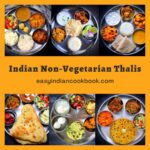Conquer your busy week with the ultimate guide to freezing delicious, egg-free meals! Imagine a freezer stocked with vibrant, flavorful options, ready to nourish you without the daily dinner-prep scramble. This isn’t just about convenience; it’s about reclaiming your time and energy, while still enjoying wholesome, satisfying meals. We’ll explore the best egg-free recipes for freezing, from hearty stews to satisfying curries, along with foolproof techniques to ensure your meals remain delicious and nutritious after thawing. Prepare to transform your weeknight dinners from a chore into a joyful experience.

This comprehensive guide dives deep into the art of freezing egg-free meals, providing practical steps and expert tips. We’ll cover everything from selecting the right containers and labeling your creations to mastering the thawing and reheating process, preserving both the taste and texture of your culinary masterpieces. Get ready to unlock a world of flavorful freedom, one frozen meal at a time.
Best Egg-Free Meal Types for Freezing
Freezing meals is a fantastic way to save time and reduce food waste, especially for busy individuals. Choosing the right meal types, however, is crucial for maintaining both texture and flavor after thawing. This section will highlight several egg-free options perfectly suited for freezing and offer practical tips for preserving their quality.
Egg-Free Meals Ideal for Freezing
Several egg-free meals retain their deliciousness and appealing texture after freezing. Proper preparation and freezing techniques are key to achieving optimal results. Here are five excellent choices:
- Soups and Stews: Hearty vegetable soups, lentil stews, and creamy tomato soups freeze exceptionally well. Their flavors often deepen during freezing, and the texture remains largely unchanged after thawing. A slight thickening may occur, but this is easily remedied with a splash of broth or water.
- Chili: The robust flavors of chili are enhanced by freezing. The texture remains relatively consistent, although some separation of the ingredients may occur. This is easily corrected with a quick simmer after thawing.
- Pasta Sauces: Thick pasta sauces, particularly those based on tomatoes or vegetables, are ideal for freezing. Avoid freezing pasta with the sauce; freeze the sauce separately and combine when reheating. The sauce’s texture may thicken slightly upon thawing, but this usually doesn’t detract from its taste.
- Curries: Many curries, especially those featuring vegetables and legumes, are well-suited for freezing. The rich flavors often intensify, and the texture remains relatively unchanged, though some thickening might occur. Add a little liquid if needed after thawing.
- Vegetable Purees: Smooth vegetable purees, like pumpkin or butternut squash puree, freeze beautifully. Their creamy texture remains largely intact after thawing, making them perfect for adding to soups, stews, or as a side dish.
Tips for Maintaining Meal Quality During Freezing
Freezing your meals properly ensures they retain their quality and flavor. Here are three essential tips:
- Cool Completely: Before freezing, allow your meals to cool completely to room temperature. Freezing hot food can create ice crystals that alter the texture and flavor.
- Use Freezer-Safe Containers: Select airtight, freezer-safe containers or bags to prevent freezer burn and maintain the freshness of your meals. Leave some headspace in containers to allow for expansion during freezing.
- Label and Date: Clearly label each container with the contents and the date of freezing. This helps you track the age of your frozen meals and ensures you use them within the recommended timeframe (ideally within 3-6 months).
Freezing and Thawing Times for Egg-Free Meals
| Meal Type | Freezing Time (approx.) | Thawing Method | Reheating Method |
|---|---|---|---|
| Soups & Stews | 2-3 hours in a shallow container | Refrigerator overnight | Stovetop or microwave |
| Chili | 2-3 hours in a shallow container | Refrigerator overnight | Stovetop or microwave |
| Pasta Sauces | 2-3 hours in ice cube trays or small containers | Refrigerator overnight or quick thaw in cold water | Stovetop or microwave |
| Curries | 2-3 hours in a shallow container | Refrigerator overnight | Stovetop or microwave |
| Vegetable Purees | 2-3 hours in ice cube trays or small containers | Refrigerator overnight or quick thaw in cold water | Microwave or add directly to dishes |
Tips for Planning and Preparing Egg-Free Freezer Meals
Planning and preparing egg-free freezer meals for busy weeks requires a strategic approach to maximize efficiency and minimize time spent in the kitchen during the week. By thoughtfully organizing your ingredients, cooking methods, and storage, you can create a delicious and convenient stockpile of ready-to-eat meals. This section offers practical tips and a sample plan to guide you through the process.
Efficient Meal Planning for Egg-Free Freezer Meals
Effective meal planning is crucial for streamlining the entire process. Begin by selecting egg-free recipes that are freezer-friendly and align with your dietary preferences and available time. Consider recipes that use similar ingredients to reduce shopping trips and minimize food waste. A well-organized plan ensures you purchase only what you need and avoid unnecessary trips to the grocery store. This strategy is particularly helpful for those with busy schedules.
Batch Cooking Techniques for Egg-Free Meals
Batch cooking is the cornerstone of efficient freezer meal preparation. Choose recipes that lend themselves well to large-batch cooking, such as soups, stews, or chili. Prepare multiple portions simultaneously, utilizing the same cooking methods and equipment. This approach dramatically reduces cooking time in the long run. For instance, instead of making one pot of lentil soup, prepare three or four, cooling them completely before portioning and freezing.
Optimizing Ingredient Preparation for Freezer Meals
Before beginning the cooking process, dedicate time to prepping ingredients. Chop vegetables, measure spices, and portion out grains and proteins in advance. This pre-preparation significantly reduces cooking time and minimizes the chances of rushing during the actual cooking process. Imagine pre-chopping a large batch of onions and peppers – this small step saves valuable minutes during each cooking session.
Proper Portioning and Packaging for Freezer Storage
Using appropriate containers is key to preserving the quality and preventing freezer burn. Portion your meals into individual or family-sized containers, depending on your needs. Utilize freezer-safe containers or heavy-duty freezer bags, ensuring a tight seal to prevent air exposure. Label each container clearly with the meal name and the freezing date. This simple step ensures easy identification and helps manage food inventory effectively.
A Sample Weekly Egg-Free Freezer Meal Plan
This sample plan incorporates three egg-free recipes (assuming these have been previously defined and detailed) and suggests additional options.
| Day | Meal | Notes |
|---|---|---|
| Monday | Lentil Soup (Recipe 1) | Reheat and enjoy! |
| Tuesday | Vegetable Curry (Recipe 2) | Serve with brown rice. |
| Wednesday | Black Bean Burgers (Recipe 3) | Serve on whole-wheat buns with your favorite toppings. |
| Thursday | Chickpea Pasta with Marinara Sauce | Quick and easy, made from pantry staples. |
| Friday | Quinoa Salad with Roasted Vegetables | A healthy and flavorful option. |
| Saturday | Leftovers or a simple egg-free frittata (using tofu or silken tofu) | Use up any remaining portions. |
| Sunday | Vegetable Stir-fry with Tofu | A versatile and customizable meal. |
Checklist for Preparing and Freezing Egg-Free Freezer Meals
- Plan your meals and create a shopping list.
- Purchase all necessary ingredients.
- Prepare ingredients (chop vegetables, measure spices, etc.).
- Cook meals in large batches.
- Cool meals completely before freezing.
- Portion meals into freezer-safe containers or bags.
- Label containers with the meal name and freezing date.
- Freeze meals properly.
Mastering the art of freezing egg-free meals is a game-changer for busy individuals seeking healthy and convenient dining. By following the simple yet effective techniques Artikeld in this guide, you’ll not only save precious time and energy but also enjoy delicious, home-cooked meals throughout the week. From careful portioning and proper labeling to optimal thawing and reheating methods, each step contributes to the overall success of your freezer meal journey. Embrace the convenience and savor the flavors – your taste buds and your schedule will thank you.
User Queries
Can I freeze egg-free meals in plastic bags?
While possible for some meals, freezer-safe containers are generally recommended to prevent freezer burn and maintain food quality. Bags can also be prone to leaks.
How long can I keep egg-free meals frozen?
Most egg-free meals can be safely stored in the freezer for 2-3 months, maintaining optimal quality. Always check for freezer burn before consumption.
What’s the best way to thaw frozen egg-free meals?
The safest method is thawing in the refrigerator overnight. For quicker thawing, you can use the defrost setting on your microwave, but ensure the food is thoroughly heated afterward.
Can I refreeze thawed egg-free meals?
It’s generally not recommended to refreeze thawed meals, as this can compromise food safety and quality. Always consume thawed meals within a day or two.


